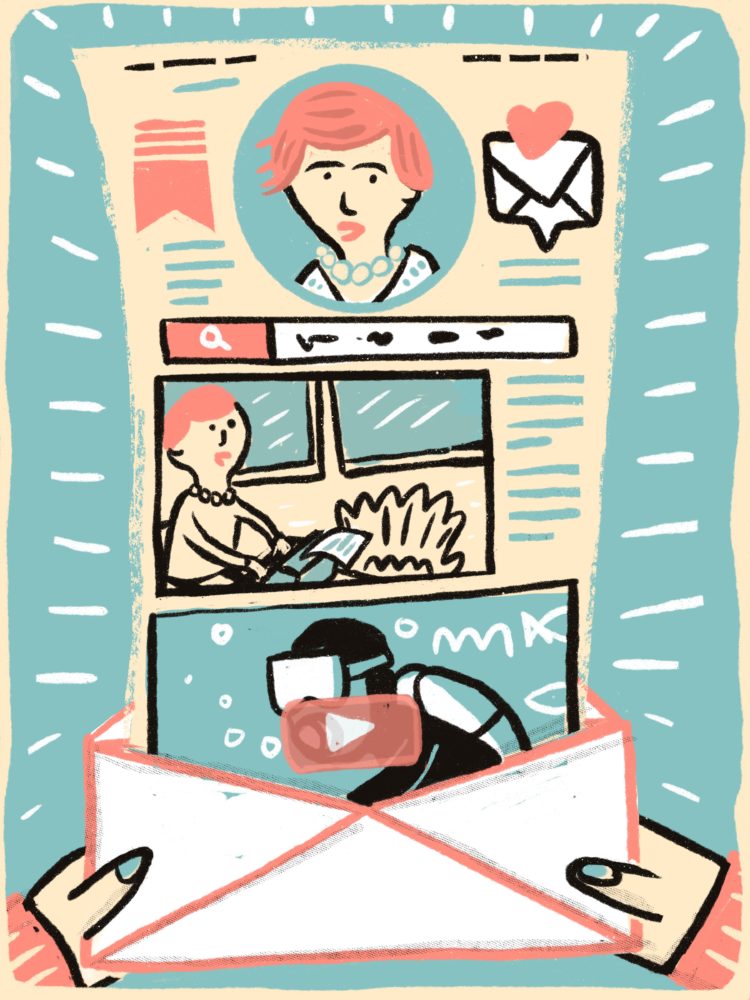If you’ve been wondering what the “new thing” is for writing outlets, it turns out the outlet has swung back to your email inbox. Email newsletters by writers have been popping up for the last few years, first via the platform Tiny Letter, and more often now via Substack.

“Email newsletters can offer a literal buy-in from subscribers…” Illustration by Josh Quick
You might have had one forwarded to you by a friend, and thought, “Hey, I could do that too!” but before you sign up, you should also consider how newsletters by writers function in the big playing field of writing outlets.
How are newsletters by writers different than an email or a blog?
So, in a nutshell: instead of just writing a friend or a few colleagues about what’s going on with your life, you can choose to make a newsletter that anyone can subscribe to.
Plus newsletters let you:
- Pick a genre or topic to write about exclusively (or don’t, it’s up to you)
- Have a couple of different tiers, like a free newsletter and a subscription-based one, to monetize your writing with subscribers
- Use the newsletter as a reason to write with a regular deadline
But, this isn’t your average Christmas card newsletter update (though, I guess you could use it for things like that). Instead, it’s a kind of a directed sharing of your particular worldview.
This feels like something we’ve seen before
There’s been a bit of nostalgia at play here, for sure, as middle-aged writers harken back to a simpler time when the internet was a lot of Live Journal. It was a more unique, though possibly more labor-intensive, way to read online, before algorithms and disappearing Snapchats made us all a little bit nuts with our “feeds.”
Younger writers also might not remember a time when you didn’t have to feel plugged in to everyone’s social updates all the time. Newsletters by writers are much more like a letter you’d get in the mail, and offer a bit of a calm respite apart from of a wildly vacillating social cycle.
And there’s a little bit of money to be made, too. Instead of words just hanging out online in a blog, these new email newsletters can offer a literal buy-in from subscribers. Most, if not all, newsletters by writers offer a free “light” version and some offer a subscription model that includes either deeper content or more frequent updates. You have to decide if what you’re reading is entertaining or worth paying a bit of money for (on average around $5/month). It’s not much income, but it might help a writer out with some bills, or just pay them for the time they took to write.
Is this all terribly techie and hard?
Not really? Everyone who told you that making your own website or blog is easy was probably just wildly overestimating your computer skills. But using free software to make an email newsletter is relatively easy. Swear.
“Substack handles all of the tech and administration for your Substack website, email newsletter, paid subscriptions, and even podcast and discussion threads so that creators can focus on the hard part: writing and producing great content,” Fiona Monga who leads the Partnerships initiatives at Substack said. “For the more visual creators specifically, one thing to note is that you’re able to embed tweets, YouTube videos, Vimeo videos, Instagram photos, Spotify tracks, and SoundCloud on your Substack publication. All you need to do is copy and paste the relevant URL into the Substack editor—you don’t need to wrangle with an embed code. It’s very fast and simple.”
Substack is free to use, but takes a percentage of your paid subscriptions if you offer them. Tiny Letter, a platform that preceded the email newsletter trend, doesn’t support paid subscriptions, and some users are leaving it for the more monetizable model. You could also use a regular newsletter service like MailChimp or any other way you’d like to do it—as long as you’re managing your subscribers properly and not spamming anybody. (Heck, you could even just start typing one out and sending it via the postal service if you wanted to.)
Some notable newsletters you might read before you start your own
Writers around the world have been using the above-mentioned services, and others, to send out personal email newsletters for a few years. Some newsletters by writers are reaching the end of their lifespan and have announced they’ll end soon, while new ones are still popping up all the time.
Some favorites of mine and some suggested by friends include:
- Here for it by R. Eric Thomas
- Nicole Knows by Nicole Cliffe
- Adventuress by Rachel Syme
- Welcome to Hell World by Luke O’Neil
- High Drama by Louis Peitzman
- Feminism and Dogs from Kate Harding
- Notes from a Small Press by Anne Trubek
- impeachment.fyi by Dan Sinker
- Think & Wonder by Kyla Mandel
- The collected ahp by Anne Helen Petersen
- Agents and Books by Kate McKean
- Men Yell at Me by Lyz Lenz
- The Small Bow
- The Ankler by Richard Rushfield
- The D-Train by Amy Blair
In Part 2 of this series, I’ll provide insights on the newsletters by writers trend by real-life authors who chose to take up the task (and why they’ve decided to add another outlet for their words).
Want to read more from this author in the meantime? Check out Anne Holub’s post on NaNoWriMo, the ultimate novel challenge.

